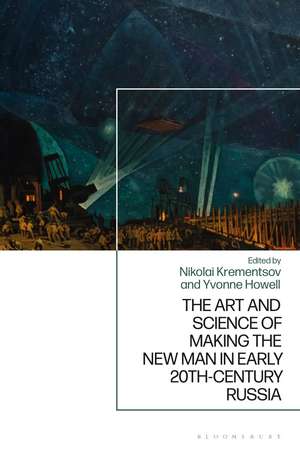The Art and Science of Making the New Man in Early 20th-Century Russia
Editat de Professor Yvonne Howell, Professor Nikolai Krementsoven Limba Engleză Paperback – 28 iun 2023
| Toate formatele și edițiile | Preț | Express |
|---|---|---|
| Paperback (1) | 192.90 lei 43-57 zile | +73.34 lei 6-12 zile |
| Bloomsbury Publishing – 28 iun 2023 | 192.90 lei 43-57 zile | +73.34 lei 6-12 zile |
| Hardback (1) | 541.20 lei 43-57 zile | |
| Bloomsbury Publishing – 29 dec 2021 | 541.20 lei 43-57 zile |
Preț: 192.90 lei
Preț vechi: 250.19 lei
-23% Nou
Puncte Express: 289
Preț estimativ în valută:
36.92€ • 40.12$ • 31.04£
36.92€ • 40.12$ • 31.04£
Carte tipărită la comandă
Livrare economică 21 aprilie-05 mai
Livrare express 15-21 martie pentru 83.33 lei
Preluare comenzi: 021 569.72.76
Specificații
ISBN-13: 9781350232846
ISBN-10: 135023284X
Pagini: 296
Ilustrații: 32 bw illus
Dimensiuni: 156 x 234 x 25 mm
Greutate: 0.42 kg
Editura: Bloomsbury Publishing
Colecția Bloomsbury Academic
Locul publicării:London, United Kingdom
ISBN-10: 135023284X
Pagini: 296
Ilustrații: 32 bw illus
Dimensiuni: 156 x 234 x 25 mm
Greutate: 0.42 kg
Editura: Bloomsbury Publishing
Colecția Bloomsbury Academic
Locul publicării:London, United Kingdom
Caracteristici
Even coverage of theories, representations and utilizations of the 'new man' concept in early 20th-century Russia
Notă biografică
Yvonne Howell is Professor of Russian and Global Studies at University of Richmond, USA. She has published extensively on Russian and Soviet science fiction and is the editor of Red Star Tales (2015).Nikolai Krementsov is Professor at the Institute for the History and Philosophy of Science and Technology, University of Toronto, Canada. He is the author of many publications, including Revolutionary Experiments (2014) and With and Without Galton (2018).
Cuprins
PrefaceList of Illustrations Introduction Nikolai Krementsov (University of Toronto, Canada)Part 1 - Nurturing the New Man1. Encyclopedic Worldbuilding: Alexander Bogdanov and the Cognitive Creation of the New Man Michael Coates (University of California, Berkeley, USA)2. 'The RoadtoLife': Educating the New Man Lyubov Bugaeva (Saint Petersburg State University, Russia)3. The New Man in the Nursery: Making Soviet Dolls and Regulating Children's Play in the 1920s and 30s Olga Ilyukha (Russian Academy of Sciences, Russia)Part 2 - Imagining the New Man4. New Sciences, New Worlds, and 'New Men' Nikolai Krementsov (University of Toronto, Canada)5. Entertaining Sciences, Unlikely Horrors: The Changing Image of Man in Soviet Popular-Scientific Literary Genres Matthias Schwartz (Leibniz Center for Literary and Cultural Research, Germany)6. The New Man as a Monster of Eugenic Imagination: The Criminal Brain in Mikhail Bulgakov's 'Heart of a Dog' and James Whale's Frankenstein Irina Golovacheva (St. Petersburg State University, Russia)Part 3 - Displaying the New Man7. 'A School of the Peasantry of the Future': Constructing the Image of a 'New Peasant' at the 1923 All-Russian Agricultural Exhibition Olga Elina (Russian Academy of Sciences, Russia)8. Revolutionary Evolution in Apes and Humans in the 1920s: Sculpture and Constructs of the New Man at the Moscow Darwin Museum Pat Simpson (University of Hertfordshire, UK)9. A New Man in the Ethnographic Museum: Between the Socialist Content and the National Form Stanislav Petriashin (Russian Museum of Ethnography, Russia)Part 4 - ConclusionThe New Man: One Hundred Years Later Yvonne Howell (University of Richmond, USA)List of ContributorsIndex
Recenzii
Krementsov and Howell have assembled a host of original pieces of research from a range of humanities' subfields to illuminate the multiplicity of ways in which Russians negotiated, envisioned, and performed the fantasies of humankind's renovation across the first four decades of the twentieth century.
The New Man has long been recognized as a crucial topic by those who study revolutionary Russia, the early Soviet Union, and Stalinism. Its study takes a big step forward in this wide-ranging and thought-provoking volume. Delving into science, philosophy, ideology, education, literature, film, exhibitions, and more, the works gathered here aim to recover actors' meanings and intent when invoking the New Man in specific contexts. These investigations, taken together, bring us closer to understanding why the New Man became so central to the Soviet century.
The New Man has long been recognized as a crucial topic by those who study revolutionary Russia, the early Soviet Union, and Stalinism. Its study takes a big step forward in this wide-ranging and thought-provoking volume. Delving into science, philosophy, ideology, education, literature, film, exhibitions, and more, the works gathered here aim to recover actors' meanings and intent when invoking the New Man in specific contexts. These investigations, taken together, bring us closer to understanding why the New Man became so central to the Soviet century.
